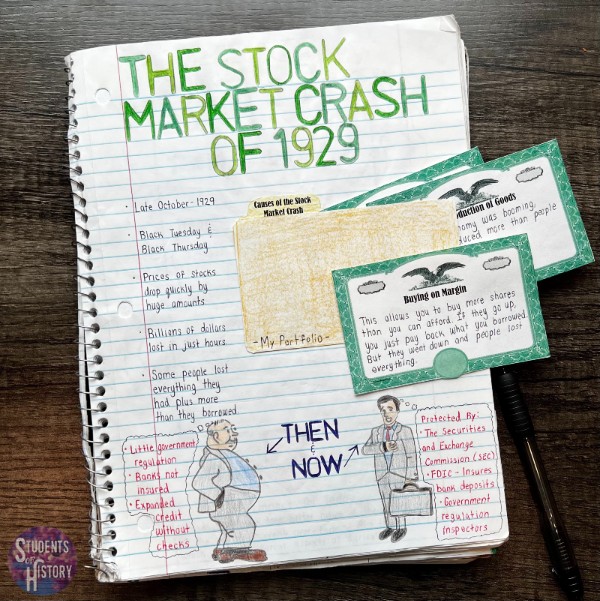5 Top Trends for Teaching Social Studies in 2024

It's the year 2024, and teaching social studies is more of a challenge than ever before. If you have been in the classroom the past few years, you know just how rough it has been. Between the students, administrators, parents, and the community, social studies teachers are feeling pressure from all directions.
There are, however, a few exciting trends, techniques, and resources that can help social studies teachers provide our students with the most engaging and effective lessons possible.
One trend that has worked for many teachers is to go back to paper-pencil interactive notebooks. Students have been overwhelmed with technology the past few years. Many of them are burned out on Google Classroom, digital activities, webquests, Kahoot, etc.
I know many of your admin require digital activities but there are easy ways to balance the digital and "analog".
For example, I will have students read an online article and complete an interactive notebook graphic organizer based on what they read.
For US History, that can be reading (or even listening to) this short article on the stock market crash of 1929 and then organizing the important parts of the article into their interactive notebook:

This allows students to be hands on with their learning and easily combine a digital resource with a paper/pencil activity.
I have these available for my entire curricula in World and US History.
Another trend in social studies education is the emphasis on project-based learning. This approach allows students to learn by actively participating in the process of discovering new knowledge and solving real-world problems. In a social studies context, this might involve students working in groups to research and present a report on a particular historical event or issue. By actively engaging with the material in this way, students are able to develop critical thinking skills and a deeper understanding of the subject matter.
I have a thorough World History PBL packet that can be used in any unit. It allows students to select a presentation model based on their own skills or interests.
I have had students create songs, design clothing lines, or even create a simple video game to demonstrate their understanding of a historical topic.
One of the biggest challenges facing social studies teachers today is the need to address issues of diversity and inclusivity in the classroom. With the increasing diversity of the student population, it's important that teachers are able to provide lessons that are inclusive and representative of a range of perspectives and experiences.
One way to do this is to incorporate a variety of primary sources into lessons, including documents and speeches from underrepresented groups. Examples of these that I have include:
- Ella Baker's "Bigger Than a Hamburger" speech
- Chinese Commissioner Lin letter to Queen Victoria on the opium trade
- Menelik II's letter to Europeans at the Berlin Conference
- Empress Theodora's "purple is the noblest shroud" speech.
- Benjamin Banneker letter on slavery and human equality
- A Frances Ellen Watkins Harper poem on education during Reconstruction
- And this great lesson on African decolonization with excerpts from Gamal Abdel Nasser, Kwame Nkrumah, Jomo Kenyatta, Patrice Lumumba, and Nelson Mandela
Another trend in social studies education is the use of experiential learning. This approach allows students to learn through hands-on experiences like field trips, service projects, and simulations. For example, you could take your students on a field trip to a local museum or historic site, or have them participate in a role-playing activity to learn about a particular historical event.
If you don't have any nearby historical sites to visit, many have incredibly websites that your students can use online. A couple of my favorites are Mount Vernon's "Be Washington" interactive resource and the Lascaux cave virtual tour.
By engaging with the material in a more interactive and immersive way, students are able to develop a deeper understanding of the subject matter.
My favorite resource for experiential learning in your community is my Martin Luther King Jr. Service Learning project. This uses the legacy of Dr. King to inspire student service to their community.
Lastly, an exciting trend in social studies education is to use a variety of assessment strategies to more effectively evaluate student learning. Formative assessments, which are designed to provide ongoing feedback on student progress, are becoming increasingly popular. These might include exit tickets, quizzes, or other quick checks for understanding. Additionally, teachers are using more authentic assessments, such as projects, presentations, and simulations, which allow students to demonstrate their knowledge and skills in a more meaningful way.
In my complete curricula for Civics, World, and US History I have a variety of assessment resources along with digital Google Forms options for each unit to help you out.
As I am sure you know, teaching social studies can feel like you're in a mine field and it is constantly changing. It's important to stay up to date on the latest trends and techniques so we can provide the best possible education for our students.
By blending paper and digital, using PBL, addressing diversity and inclusivity, experiential learning, varying assessments, we can create engaging and effective lessons that will help our students learn and grow.

Want to try some lessons for free?
Try out some free lesson plans and resources for your social studies classroom!
Don't worry, your information is never shared.